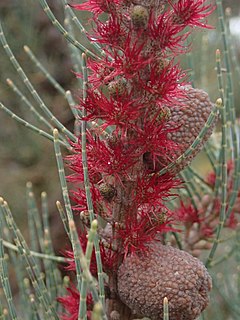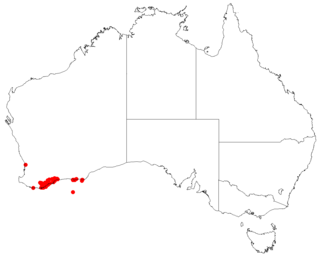
The Casuarinaceae are a family of dicotyledonous flowering plants placed in the order Fagales, consisting of four genera and 91 species of trees and shrubs native to eastern Africa, Australia, Southeast Asia, Malesia, Papuasia, and the Pacific Islands. At one time, all species were placed in the genus Casuarina. Lawrence Alexander Sidney Johnson separated out many of those species and renamed them into the new genera of Gymnostoma in 1980 and 1982, Allocasuarina in 1982, and Ceuthostoma in 1988, with some additional formal descriptions of new species in each other genus. At the time, it was somewhat controversial. The monophyly of these genera was later supported in a 2003 genetics study of the family. In the Wettstein system, this family was the only one placed in the order Verticillatae. Likewise, in the Engler, Cronquist, and Kubitzki systems, the Casuarinaceae were the only family placed in the order Casuarinales.

Allocasuarina is a genus of trees in the flowering plant family Casuarinaceae. They are endemic to Australia, occurring primarily in the south. Like the closely related genus Casuarina, they are commonly called sheoaks or she-oaks.

Casuarina is a genus of 17 tree species in the family Casuarinaceae, native to Australia, the Indian subcontinent, southeast Asia, islands of the western Pacific Ocean, and eastern Africa. It was once treated as the sole genus in the family, but has been split into four genera.

Allocasuarina fraseriana, commonly known as western sheoak, common sheoak, WA sheoak. Fraser's sheoak or just sheoak, is a tree in the family Casuarinaceae. Endemic to Western Australia, it occurs near the coast in the south west corner of the State, from Jurien to Albany . The Noongar peoples know the tree as Condil, Kulli or Gulli.

Allocasuarina huegeliana, commonly known as rock sheoak or sighing sheoak, is a tree in the family Casuarinaceae. Endemic to Western Australia, it occurs mostly throughout the Wheatbelt region. It is now especially common on road verges, where it sometimes forms thickets.

Allocasuarina lehmanniana, commonly known as dune sheoak, is a shrub in the family Casuarinaceae. Endemic to Western Australia, it is widespread along on the coast from the Murchison River south to Israelite Bay.

Allocasuarina humilis, commonly known as the dwarf sheoak or dwarf casuarina, is a woody shrub of the family Casuarinaceae endemic to the south-west of Western Australia.

Allocasuarina distyla, commonly known as scrub she-oak, is a shrub or small tree of the She-oak family Casuarinaceae endemic to New South Wales.

Allocasuarina luehmannii is a species of ironwood tree native to Australia and its wood is the hardest commercially available.

Allocasuarina decaisneana or desert oak is a medium-sized, slow-growing tree found in the dry desert regions of the Northern Territory, South Australia and Western Australia. The Anangu peoples know the tree as kurkara.

Allocasuarina verticillata, commonly known as drooping she-oak or drooping sheoak, is a nitrogen fixing native tree of southeastern Australia.

The Donnelly River is a river in the South West of Western Australia. Its main tributaries are Barlee Brook and Carey Brook. The river runs primarily through state forest reserves, although 25 private landholdings are situated along the length of the river. Clearing of the catchment area is estimated at 20% with the land mostly being used for viticulture, horticulture, dairy, grazing and tourism.

Allocasuarina crassa, commonly known as the Cape Pillar sheoak, is a species of sheoak native to Tasmania, Australia.

Allocasuarina inophloia, also known as woolly oak, or stringybark she-oak, is a shrub or small tree of the she-oak family Casuarinaceae endemic to inland New South Wales and Queensland. The hairy bark is an unusual feature.

Acacia pachyacra is a tree or shrub belonging to the genus Acacia and the subgenus Phyllodineae. that is endemic to arid parts of central and western Australia.

Allocasuarina acutivalvis is a shrub or tree of the genus Allocasuarina native to the Wheatbelt, Goldfields-Esperance and Mid West regions of Western Australia.

Allocasuarina drummondiana is a shrub of the genus Allocasuarina native to the Wheatbelt region of Western Australia.
Allocasuarina fibrosa, commonly known as the woolly sheoak, is a shrub of the genus Allocasuarina native to a small area in the central Wheatbelt region of Western Australia.

Allocasuarina thuyoides, commonly known as the horned sheoak, is a shrub of the genus Allocasuarina native to a large area in the Mid West, Wheatbelt, South West and Goldfields-Esperance regions of Western Australia.

Allocasuarina trichodon is a shrub of the genus Allocasuarina native to an area along the south coast in the Great Southern and Goldfields-Esperance regions of Western Australia.




















